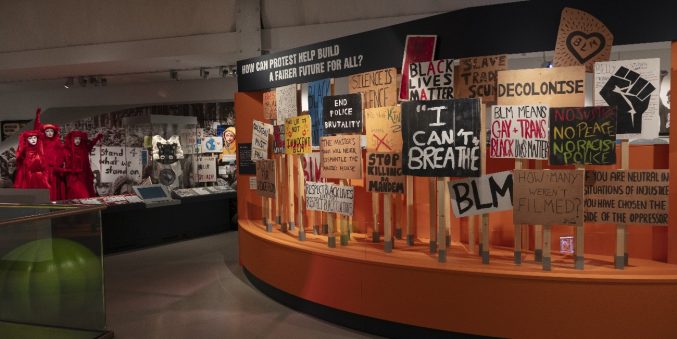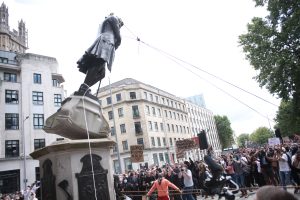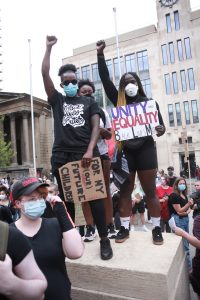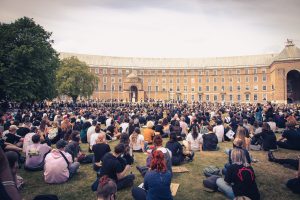New display at M Shed: the toppling of the Colston statue
Posted on by Fay Curtis.
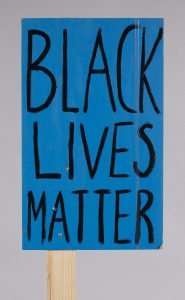 by Helen McConnell Simpson, Senior Curator of History
by Helen McConnell Simpson, Senior Curator of History
Today we have launched an extended display at M Shed about the history of protest in Bristol, with the permanent inclusion of the statue of slave trader Edward Colston, which was pulled down during a Black Lives Matter march in 2020.
The new display focuses on the protest in which the statue was toppled. It features first-hand accounts from protestors and shares the perspectives of those opposed to the toppling. The display contextualises the statue into the wider picture of protest against racial injustice over the last 400 years, both in Bristol and around the world.
Why has the Colston statue been put on display?
In the summer of 2021, the statue was put on display temporarily, to support the public conversation on what should happen to the statue. The We Are Bristol History Commission ran a public consultation which received 14,000 responses, half of them from Bristol residents. 80 per cent of city residents who responded said the statue should be displayed in a museum in Bristol. The History Commission also recommended that the statue should be displayed lying down, without being cleaned up, to show what happened to it during the protest.
Is the statue now part of the museum’s permanent collection?
The whole statue, both the plinth and the bronze figure, are Grade II listed. The toppling separated the bronze statue from the plinth. In February 2024, Bristol City Council’s Development Control Committee approved an application for listed building consent to move the bronze part of the statue from the city centre to M Shed. The bronze figure has now become a permanent part of Bristol Museums’ collections, but the plinth will remain in place as a listed structure. As part of our collection, we will look after the statue forever, and, as with all items, do our best to preserve it in its current state, graffiti and all.
How did M Shed decide what to include in the new display?
For almost four years, staff at M Shed have been discussing how to display the statue and which stories to tell about it with members of the public, community leaders, academics and other museums across the country. So, following on from the work of the History Commission, we had a good starting point of understanding the range of people’s views and concerns. To help us narrow this down to what was essential to include in a relatively small display, we gathered a working group of local academics, artists, activists, historians, and community leaders. Together, the working group created a set of guidelines and key messages, which M Shed staff then followed in creating the display.
What is the thinking behind the new display?
The working group recommended that the display should aim to create a space where people could consider different perspectives on the toppling of the statue and reflect on the bigger picture in which this one incident sits. A lot of people in Bristol’s African Caribbean community told us that the underlying issues of racial injustice were much more important than the statue itself, or Edward Colston as an individual. We decided that the best place for this conversation was in the Protest section of the Bristol People gallery at M Shed.
Many people have different views on Colston and the toppling of the statue, so it was really important to include different voices in the display. To do this, we put large quotes showing different points of view on the wall opposite the statue. The placards which were carried at the march each represent the voice of a protestor, so we included lots of these.
We screened the statue from the rest of the gallery, to allow visitors to choose whether they want to see it. We commissioned Bristol writer and director Michael Jenkins to create a short film of the protest, to help bring the display to life.
We created a timeline, in collaboration with the working group, to put the toppling of the statue in a wider context of protest against racial injustice in Bristol and around the world. We only had space to include a small selection of the important events in this story over the last 400 years. Visitors can add their own cards to the timeline, to fill some of these gaps. We also hope visitors will look to the future and include cards on what might come next in this long story.
With thanks
We gratefully acknowledge the support of Bristol Museums Development Trust and the Friends of Bristol Museums, Galleries & Archives which made this display possible.
We are extremely grateful to everyone who contributed to creating this display.
What next for M Shed?
This display is one step in a much bigger programme of work around the transatlantic trafficking of enslaved Africans and its historical impacts and contemporary legacies in Bristol. This is one of the most important topics for us to address, as the museum service for the city, and our work on it will never be finished.
In the next few years, we want to collaborate with partner organisations and members of Bristol’s communities to improve our displays about transatlantic trafficking in M Shed and The Georgian House Museum. We’re also working on lots of smaller projects which aim to make relevant documents more accessible to researchers, to review and interrogate our collections and the information we hold about them, and to include a wider range of people in our decision making.
- © Marton Gosztonyi
- © Marton Gosztonyi
- © Julian Preece Photography
